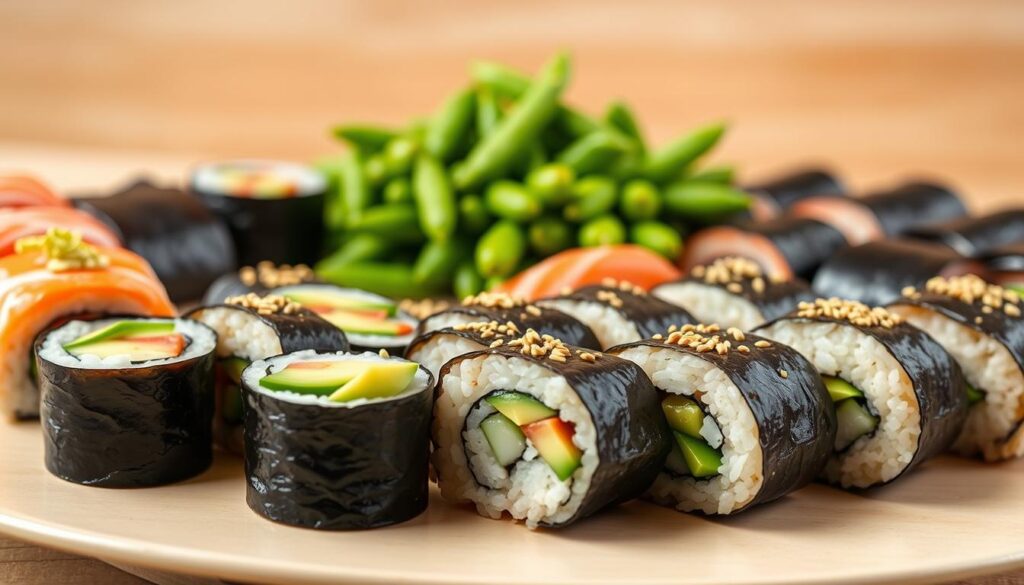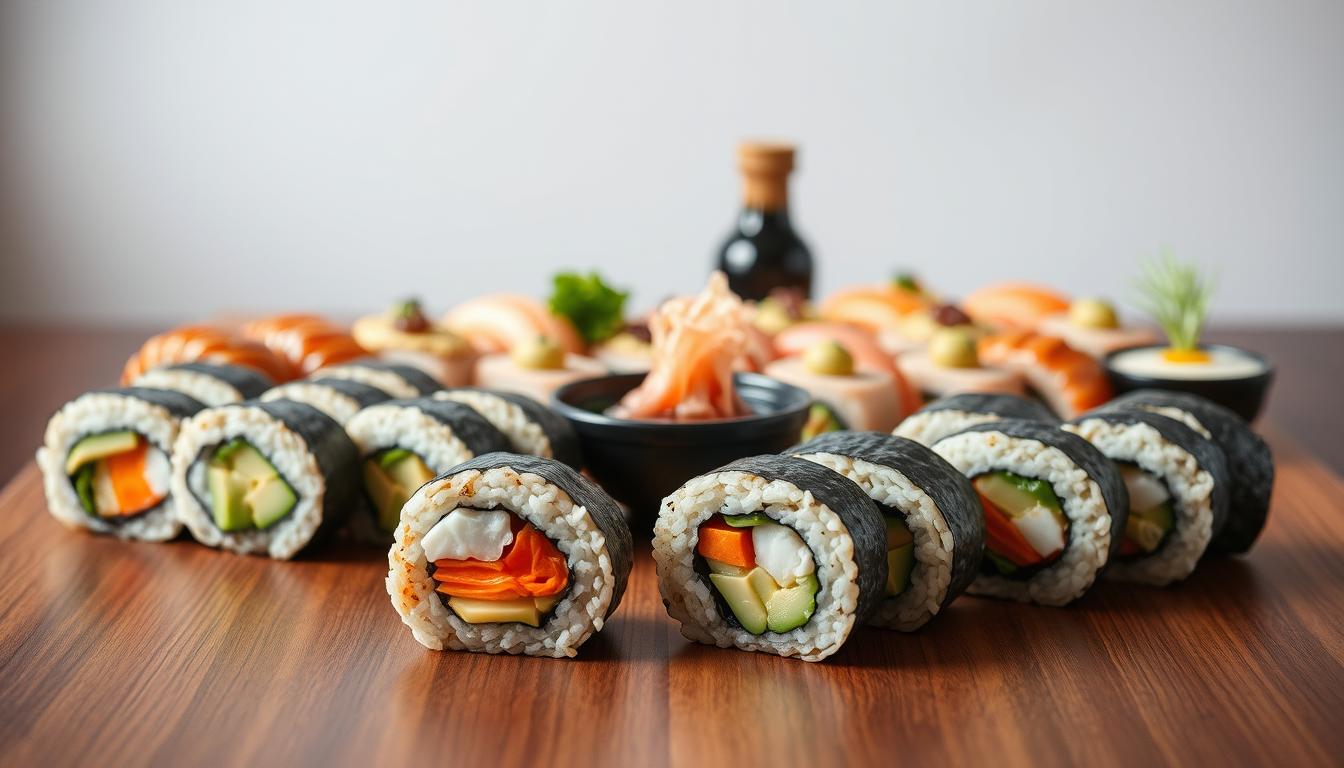Is Sushi Healthy for Diabetics? Managing diabetes means watching what you eat closely. This is especially true for foods that can change your blood sugar. You might wonder if you can still enjoy sushi while managing your diabetes.
Sushi, a dish loved by many, often makes people with diabetes curious. The good news is you don’t have to give up sushi. Instead, you can pick healthier options to enjoy it as part of a balanced diet.
Knowing the good and bad about sushi can guide your choices. By picking the right ingredients and watching your portion sizes, you can enjoy sushi without harming your health.
Table of Contents
Understanding Diabetes and Nutrition
For those with diabetes, knowing about nutrition is key to keeping blood sugar levels healthy. Diabetes makes it hard for the body to control blood glucose. This is because it either doesn’t make enough insulin or can’t use it well.
What is Diabetes?
Diabetes is a long-term health issue that changes how the body uses food for energy. It mainly comes in two types: Type 1, where the body can’t make insulin, and Type 2, where it can’t use insulin well. Knowing about diabetes is the first step in managing diabetes with sushi and other foods.
“Diabetes is a complex condition that requires a multifaceted approach to management, with diet playing a pivotal role,” as emphasized by health experts.
The Role of Diet in Diabetes Management
Diet is very important in managing diabetes. What you eat directly affects your blood sugar levels. Foods with a high glycemic index can raise blood sugar, while low glycemic foods help keep it stable. So, knowing the glycemic impact of foods, like sushi, is crucial.
- Choosing foods that are rich in nutrients and fiber
- Avoiding foods high in added sugars and saturated fats
- Being mindful of portion sizes to maintain a healthy calorie intake
By making smart food choices, you can manage your diabetes better and stay healthy. This means knowing how different foods, like sushi, affect your sushi and blood sugar levels.
Nutritional Benefits of Sushi
Sushi is great for diabetics because of its nutritional value. It’s made from rice, fish, veggies, and seaweed. These ingredients give you omega-3s, vitamins, and minerals.
Essential Ingredients in Sushi
The nutrients in sushi come from its ingredients. Fish is full of omega-3 fatty acids, which are good for your heart. Veggies add fiber and vitamins, and seaweed gives you minerals like iodine. Even though rice has carbs, it can be part of a healthy meal if eaten in small amounts.
How Sushi Can Fit into a Balanced Diet
To fit sushi into a healthy diet, make smart choices. Choose low-carb sushi or sashimi to cut down on carbs. Pick fish with lots of omega-3s for more nutrients. Also, use less sauce because many are sweet.
Knowing the good stuff in sushi and making smart picks lets you enjoy it while keeping your diabetes in check.
The Glycemic Index and Sushi
If you have diabetes, knowing the glycemic index of sushi is crucial. The glycemic index (GI) shows how fast foods raise your blood sugar. Knowing the GI of sushi helps you manage your diabetes better.
What Is the Glycemic Index?
The GI ranges from 0 to 100, ranking foods by their blood sugar impact. Foods with a high GI are quickly digested, causing blood sugar to spike fast. Foods with a low GI digest slowly, leading to a gradual blood sugar increase.
Sushi rice, a key part of sushi, has a high GI. This is because it’s made with vinegar, sugar, and salt. This can be a problem for diabetics, as it can raise blood sugar levels a lot.
Sushi Varieties and Their Glycemic Impact
Different sushi types have different GI values. This depends on their ingredients and how they’re made. For example:
- Sashimi, raw fish sliced thin, has a low GI since it doesn’t have rice.
- Maki rolls with lots of carbs or toppings have a higher GI because of the rice.
- Nigiri, sushi with raw or cooked seafood, has a moderate GI, depending on the rice.
Here’s a table showing GI values for different sushi types:
| Sushi Type | Glycemic Index (GI) | Description |
|---|---|---|
| Sashimi | Low (0-10) | Raw fish without rice |
| Nigiri | Moderate (40-60) | Raw or cooked seafood on rice |
| Maki Rolls | High (60-80) | Rolled sushi with rice and fillings |
Knowing the GI of sushi helps you choose better for your blood sugar. Opting for sashimi or nigiri with low-GI ingredients is a healthier choice for diabetics.
Choosing the Right Sushi for Diabetics
Diabetics can still enjoy sushi by choosing wisely. It’s important to pick sushi and ingredients that won’t raise blood sugar too much. This way, you can enjoy sushi while keeping your diet in balance.
Types of Sushi That Are Healthier Choices
Choosing sushi low in carbs and sugars is smart. Sashimi, which is raw fish without rice, is a great pick. It’s low in carbs but high in protein, making it healthy.
Nigiri, or hand-formed sushi, is also a good choice. It has a small amount of rice and is topped with fish or seafood.
Maki rolls can be healthy if they have less rice and no added sugars or fried stuff. Look for rolls with vegetables or lean proteins for a balanced diet.
| Type of Sushi | Carb Content | Recommendation |
|---|---|---|
| Sashimi | Low | Excellent choice |
| Nigiri | Moderate | Good choice |
| Maki Rolls (with vegetables or lean proteins) | Varies | Choose wisely |
Ingredients to Avoid
While sushi can be healthy, some ingredients are bad for diabetics. Fried ingredients like tempura bits add a lot of calories and carbs. Also, sugary sauces like eel sauce or spicy mayo can raise blood sugar.
Stay away from sushi rolls with high-carb ingredients like crab sticks or sweetened fillings. Being careful with these ingredients helps you enjoy sushi while managing your diet.

Portion Control and Serving Size
Managing diabetes with sushi means watching your serving sizes carefully. As a diabetic, you need to keep an eye on carbs in your meals to control blood sugar. Sushi can be healthy or risky, depending on what you eat and how much.
Even healthier sushi choices should be eaten in small amounts. Knowing a safe serving size for you is key. This means understanding the sushi type, its ingredients, and how much you’re eating.
How Much Sushi is Safe for Diabetics?
Finding a safe sushi amount depends on carbs, ingredients, and your diet needs. It’s wise to limit sushi to 1-2 rolls (6-12 pieces) per serving. This depends on the roll’s size and ingredients.
Here’s a table to help you understand sushi carb counts:
| Type of Sushi | Carb Count per Piece | Carb Count per Roll (6-8 pieces) |
|---|---|---|
| Sashimi | 0-1g | 0-8g |
| Nigiri (without sauce) | 1-2g | 6-16g |
| Maki Rolls (without rice, with veggies) | 2-4g | 12-32g |
| Maki Rolls (with rice and fillings) | 5-7g | 30-56g |
| Temaki (hand rolls) | 10-15g (per roll) | N/A |
By watching carb counts and portion sizes, you can enjoy sushi safely. It’s also smart to talk to a healthcare provider or dietitian for advice tailored to you.
For low-carb sushi for diabetics, choose sashimi, nigiri, or rolls with low-carb fillings. Always check ingredients and portion sizes to fit your diet plan.
Sushi Preparation Methods
Knowing how sushi is made is key for diabetics who want to eat it safely. The way sushi is prepared can change its health value. This means some types are better for diabetics than others.
Sushi making uses different methods, from old ways that focus on freshness to new ones with extra ingredients. Traditional sushi preparation uses fresh, quality ingredients. This keeps sushi’s nutritional value high.
Traditional vs. Modern Sushi Techniques
Traditional sushi keeps things simple to preserve natural flavors and nutrients. Modern sushi, however, might add ingredients or cooking methods that change its health profile.
- Traditional techniques: Focus on freshness and simplicity, often using raw fish and few ingredients.
- Modern techniques: May include cooked ingredients, extra sauces, or unique methods that can impact glycemic index and nutrition.
For diabetics, knowing these differences helps make better choices about sushi ingredients for diabetes. Opting for traditional sushi is healthier because it has less sugar and processed stuff.
Impact on Nutritional Value
The nutritional value of sushi depends on how it’s made. Traditional sushi is often lower in sugar and unhealthy fats, making it a best sushi choice for diabetics. But, modern sushi with lots of sauce or fried ingredients can be higher in calories and sugar.
To enjoy sushi safely as a diabetic, choose low-sugar, low-fat options. Go for sashimi or simple maki rolls with fresh, raw ingredients.
- Opt for traditional sushi preparations that emphasize freshness and simplicity.
- Be mindful of added ingredients and sauces that can increase the sugar and calorie content of sushi.
- Choose sushi rolls with brown rice or other whole grains for added fiber.
By understanding sushi preparation and its nutritional impact, diabetics can include it in a healthy diet. It’s about making informed choices that fit your dietary needs.
Sushi Toppings and Sauces
Sushi toppings and sauces are key to its glycemic impact. While sushi can be healthy, some toppings and sauces can raise its sugar content.
Common Toppings and Their Glycemic Effects
Some sushi toppings are better for diabetics than others. For example, avocado and cucumber are low in carbs and won’t raise blood sugar much. But, tempura bits or sweetened tobiko are high in sugar and carbs.
Choosing the right toppings is crucial. Go for fresh fish, vegetables, and seaweed to keep your sushi healthy. A study found that omega-3 fatty acids in fish can improve insulin sensitivity.
“The key to enjoying sushi as a diabetic is making informed choices about toppings and sauces.”
Healthier Sauce Alternatives
Traditional sushi sauces like soy sauce and teriyaki sauce are high in sugar and sodium. But, there are better options. Try low-sodium soy sauce or yuzu juice for flavor. You can also make your own sauces with ginger and garlic for taste and health benefits.
When eating out, ask your server about sauce and topping ingredients. Being informed helps you make choices that fit your diet.
The Role of Fish in Sushi
Fish is a key part of sushi, packed with omega-3 fatty acids good for the heart. For people with diabetes, eating fish in sushi can be a smart choice. Just be careful about the fish types and how they’re prepared.
Omega-3 Fatty Acids and Their Benefits
Omega-3 fatty acids in fish help lower inflammation, boost heart health, and support brain function. A study in the Journal of the American Heart Association found they can also lower blood fats and heart disease risk.
“The American Heart Association recommends eating fish rich in omega-3 fatty acids, such as salmon and sardines, at least twice a week for heart health benefits.”
For diabetics, these benefits are especially important since they face a higher risk of heart problems. Adding omega-3 rich fish to sushi is a tasty way to help manage this risk.
Options for Lower Mercury Fish
It’s crucial to pick fish low in mercury to avoid health risks. Mercury can harm the nervous system and kidneys. The FDA suggests choosing fish with lower mercury levels, like:
- Salmon
- Sardines
- Anchovies
- Pollock
| Fish Type | Mercury Level | Omega-3 Richness |
|---|---|---|
| Salmon | Low | High |
| Sardines | Low | High |
| Shark | High | Low |
| Anchovies | Low | High |
Choosing sushi with lower mercury fish lets you enjoy its nutritional benefits while avoiding mercury. Always ask your sushi place about their fish choices.

By picking lower mercury fish in sushi, you can make it part of a healthy diet. This supports your overall health and diabetes care.
Sushi and Blood Sugar Management
Diabetics can enjoy sushi by knowing how it affects their blood sugar. It’s important to understand the impact of different sushi types. This knowledge helps manage blood sugar levels.
Strategies for Eating Sushi Responsibly
To control your blood sugar while eating sushi, follow these tips:
- Choose sushi with low-carb ingredients, such as sashimi or rolls with cucumber or avocado.
- Opt for brown rice instead of white rice when possible, as it has a lower glycemic index.
- Be mindful of the portion size; a smaller serving can help manage carbohydrate intake.
- Avoid high-sugar sauces and toppings that can cause a spike in blood sugar.
A study in the Journal of the Academy of Nutrition and Dietetics found that managing carbs is key for blood sugar control. [1] This is especially true for sushi, as carbs vary by type.
“The key to incorporating sushi into a diabetic diet is balance and awareness of the nutritional content,” says a registered dietitian. “By making informed choices, diabetics can enjoy sushi while maintaining their blood sugar levels.”
Tracking Blood Sugar Levels After Sushi
It’s crucial to monitor your blood sugar after eating sushi. This helps you see how your body reacts to different sushi types. It guides you in making better choices next time.
| Type of Sushi | Carb Content (g) | Impact on Blood Sugar |
|---|---|---|
| Sashimi | 0-5 | Low |
| Avocado Roll | 30-40 | Moderate |
| Tempura Roll | 60-80 | High |
By tracking your blood sugar and knowing the carbs in sushi, you can enjoy it safely. This way, you can manage your diabetes effectively.
Dispelling Myths About Sushi
Sushi is often misunderstood when it comes to diabetes management. This leads to unnecessary dietary restrictions. You can enjoy sushi while managing your diabetes, if you make informed choices.
Common Misconceptions About Sushi and Diabetes
One common myth is that all sushi is high in sugar and carbs, making it bad for diabetics. But this isn’t true. Some sushi has more carbs because of the rice, but others are lower, especially those with more protein and fiber.
Diabetic-friendly sushi options include sashimi, which is just raw fish without rice. Rolls made with brown rice or cauliflower rice alternatives are also good choices. These help you manage your carb intake.
Another myth is that sushi is always high in mercury. It’s true that some fish in sushi can have mercury. But, there are many low-mercury fish options like salmon and tilapia.
| Sushi Type | Carb Content | Diabetic Suitability |
|---|---|---|
| Sashimi | Low | High |
| Brown Rice Rolls | Moderate | Moderate |
| White Rice Rolls | High | Low |
By understanding the facts and choosing the best sushi choices for diabetics, you can enjoy sushi as part of a balanced diet. Always think about the ingredients, portion sizes, and nutritional content to make good choices.
Conclusion: Enjoying Sushi as a Diabetic
You can enjoy sushi as part of a balanced meal plan when managing diabetes. With mindful choices and portion control, sushi can be a healthy addition to your diet.
Practical Tips for Diabetics
To incorporate sushi into your meal plan, choose rolls with lean protein and vegetables. Be cautious with portion sizes. Opt for brown rice or cauliflower rice for a lower glycemic impact.
When managing diabetes with sushi, consider the ingredients and preparation methods.
Healthy Sushi Choices
Selecting the right type of sushi is crucial. Sashimi and nigiri with lower mercury fish are good options. Be aware of sauces and toppings that can increase the sugar and calorie content of your sushi.
By making informed choices, you can enjoy sushi while maintaining control over your blood sugar levels.
By being mindful of your sushi choices, you can savor this cuisine while keeping your diabetes management on track. You can determine if is sushi healthy for diabetics based on your individual nutritional needs and preferences.
FAQ
Is sushi healthy for diabetics?
Sushi can be healthy for diabetics if you pick the right kinds. Sashimi or nigiri with low-carb and sugar ingredients are good choices.
What are some diabetic-friendly sushi options?
Good options for diabetics include sashimi, nigiri, and rolls with cucumber or avocado. Avoid those with tempura bits or sweet sauces.
How does sushi affect blood sugar levels?
Sushi’s effect on blood sugar depends on its type and ingredients. Low-carb options like sashimi or nigiri are safer. High-carb or sugar ingredients can raise blood sugar.
What is the glycemic index of sushi, and how does it impact diabetes management?
Sushi’s glycemic index (GI) changes with its ingredients. White rice can spike blood sugar, while brown rice or veggies are safer.
Can I manage diabetes with sushi?
Yes, managing diabetes with sushi is possible. Choose low-carb and sugar options and watch your portion sizes.
What are some low-carb sushi options for diabetics?
Diabetics can enjoy sashimi, nigiri, and rolls with cucumber or avocado. Try brown rice or cauliflower rice instead of white rice.
How do sushi ingredients impact diabetes management?
Ingredients like fish, veggies, and brown rice are good for diabetes. But white rice, high-carb sauces, and sweet toppings are not.
What are the best sushi choices for diabetics?
Diabetics should choose sashimi, nigiri, and rolls with low-carb ingredients. Opt for fish like salmon or tilapia for lower mercury.
How can I enjoy sushi while keeping my carbohydrate intake in check?
To keep carbs low, pick low-carb sushi and watch your portions. Swap high-carb ingredients for lower-carb ones.
Are there any sushi preparation methods that are healthier than others?
Traditional sushi methods with less sugar and oil are healthier. They’re better than modern methods with more carbs or sugar.


1 thought on “Is Sushi Healthy for Diabetics?”